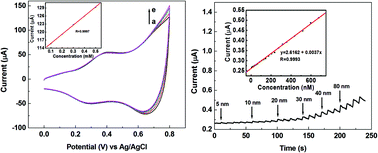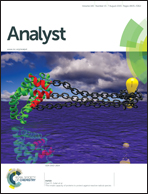Highly sensitive determination of reduced glutathione based on a cobalt nanoparticle implanted-modified indium tin oxide electrode†
Abstract
Cobalt nanoparticle modified indium tin oxide (CoNP/ITO) electrodes fabricated by ion implantation were applied for the detection of reduced glutathione (GSH). The CoNP/ITO electrode was characterized by scanning electron microscopy (SEM), energy dispersive X-ray (EDX) detector and X-ray photoelectron spectroscopy (XPS). The assay performance with regard to GSH were evaluated by cyclic voltammetry (CV) and chronoamperometry (I–t). The proposed sensor exhibited a much higher electrocatalytic activity toward the oxidation of GSH than the bare ITO electrode, with a detection limit of 5 nM. The CoNP/ITO electrode showed enhanced electrocatalytic properties, high sensitivity, good long-term stability and reproducibility as well as a rapid response to detect GSH. In addition, the CoNP/ITO electrode was also used to analyse the GSH concentration in eye drop samples, and the results were in good agreement with the labelled values.


 Please wait while we load your content...
Please wait while we load your content...